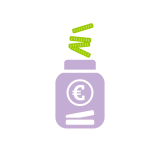Take care of your partner in the event of your death | Questions and answers
If you’re like Frank: above the age of 55 with a pension previously accrued with Philips Pensioenfonds
- A personal pension capital: Frank will keep the pension that he accrued earlier, and its value will become his personal pension capital when we switch to the new pension plan. If Philips Pensioenfonds’s finances are healthy, his personal pension capital will be topped up from the Pension Fund’s financial buffer, so his projected pension will go up a little right away. This is good news for members like Frank.
- Minor fluctuations: Frank’s personal pension capital will be invested according to his age. Members in Frank’s age category are already approaching their retirement, so the investment risk will be gradually reduced until they turn 65. After that, the investment policy is the same as for pension beneficiaries. His pension will be influenced by the economy, but major fluctuations will be avoided as much as possible. When the investments yield positive returns, a small portion will be added to the solidarity reserve. That collective reserve will benefit Frank if the economy goes badly once he’s drawing his pension.
- No choices, no compensation: Frank isn’t accruing a pension with Philips Pensioenfonds anymore, so when we make the switch he won’t be compensated for the new accrual method. Being self-employed, he can’t claim any compensation elsewhere either. However, other people his age who work for an employer might be entitled to compensation from their employer’s pension administrator. Frank doesn’t have any options to choose between now and his retirement. His pension will stay in our Pension Fund, and we’ll invest it with the exact same care as we give all our other members’ pensions.

Take care of your partner in the event of your death
- Do you currently have a survivor’s pension with Philips Pensioenfonds? Your partner and children will receive a pension from Philips Pensioenfonds in the new pension scheme, in the event of your death.
- The survivor's and orphan's pension that you have accrued with us on 1 January 2027 will continue to exist. Your partner and children will receive this in the event of your death before your retirement date.
- Are you retiring? Then you choose how much survivor's pension you want for your (possible) partner and children in the event of your death after your retirement. This is financed from your personal pension capital.

Questions & answers
for members over the age of 55 with a noncontributory pension
If a decision is made to enter (for the meaning of entry, see the answer to question 10), then non-contributory policyholders will also receive their own pension pot to which the new rules apply. The pension (capital) will therefore move more along with the economy for non-contributory policyholders.
You are wondering whether there is a difference in the increase you can expect in your pension depending on whether you retire before or after the transition to the new pension scheme.
Minor differences
For pension recipients, the expected increase in pension upon transition to the new pension scheme on 1 January 2027, is between 5% and 8% (assuming a funding ratio of 120%). Pension recipients will see this increase directly reflected in their payments starting 1 January 2027. For paid-up policyholders who are not yet retired, the amount of the first pension payment also depends on the development of the personal pension capital (e.g., through investment returns) up to the retirement date. The further in the future the retirement date lies, the less certainty there is about the payout under the new pension scheme. If the retirement date is near, the expected pension increase for a paid-up policyholder is comparable to that of someone who has just retired.
Not a decisive factor
From the above, you can conclude that the transition to the new scheme is not a decisive factor for you as a paid-up policyholder in choosing whether to retire just before or after January 1, 2027. This is different for participants who are still accruing pension with the Philips Pensioenfonds due to the compensation scheme agreed upon by the social partners. Since you are no longer accruing pension with the Philips Pensioenfonds, this is not relevant for your consideration of whether to start your pension before or after the transition. However, it may be relevant if you are currently accruing pension elsewhere and may be entitled to a compensation scheme there, and you also wish to start your pension there at the same time. If this applies to you, it is advisable to inquire with your current pension provider.
Effect of buffer allocation
It is important to realize that you will not receive a buffer for pensions already paid out. If you start your pension well before 1 January 2027, the pension paid out up to that point will no longer be part of your pension pot under the new scheme. The buffer allocation will then be calculated over a slightly smaller pension pot than if you start your pension after 1 January 2027.
If you are close to retirement, the solidarity reserve could be used for your benefit, just like existing pension beneficiaries. You will receive the same benefits as existing pension beneficiaries, and as soon as you start drawing your pension. The solidarity reserve also offers at least partial protection against financial shortfalls during the years just before you retire. So how does this work?
When you retire and we determine your initial pension benefit, we will also look at the investment returns from previous years. Those returns are spread over three years, to prevent major fluctuation in our pension beneficiaries’ income.
If the returns were negative, we will use the solidarity reserve to top of the pensions that are being drawn and avoid having to lower them. As soon as you start drawing your pension, you will be entitled to a payment from the reserve to top up your pension benefit, at the same rate as all our other pension beneficiaries. This means that the solidarity reserve also offers at least partial protection for members who are nearing retirement, and greater stability in the initial benefit that they are expected to receive.
Why do we refer to at least partial protection for members nearing their retirement? The main reason is the difference between the investment profiles before and after reaching retirement age. Before retirement, we take slightly more risk with the investments than we do after retirement. As a result, they could yield more negative returns that cannot be compensated fully from the solidarity reserve.
Example
Say that we realise a -2% investment return for pension beneficiaries in 2027. Over the 3 years that follow (based on the 3-year spread that we apply), their benefits will drop by a total of 2%, assuming that the investment returns in each of the years after 2027 are 0%. If an existing pension beneficiary has a pension of €1,000 a month on 1 January 2027, by 1 January 2031 their pension will be €980 per month, plus a monthly top-up of €20 from the solidarity reserve. In total, then, they will still have €1,000 per month.
Now say another member retires on 1 January 2031. During the 3 preceding years, this member’s investment returns were also 0% (the risk profile for members between the ages of 65 and 68 is the same as for pension beneficiaries). In 2027, this member’s investment risk was slightly higher than it was for the pension beneficiaries, and so the investment returns were -2.2%. Based on this member’s personal pension capital, they can be paid a pension of €978 per month on 1 January 2031. As a new pension beneficiary, they are entitled to a top-up from the solidarity reserve at the same rate as existing pension beneficiaries: 20 / 980 x 978 = €20. This puts their total pension at €998, which is slightly less than the €1,000 that the existing pension beneficiary receives. The difference is caused by the poorer investment returns in 2027 (-2.2% instead of -2%).
The pensions of pension beneficiaries, active members and non-contributory policyholders that have already been accrued at the time of the transition to the new system will be converted to the new pension scheme. In pension jargon, we then speak of 'itransferring' ('invaren').
The decision of the pension fund board to transfer is binding for all participants of the fund. There is no individual right of objection. However, the Accountability Body must give advice on transferring.
No, there are legal calculation rules for the distribution of the pension assets upon commencement. One of the conditions is that participants receive at least the value of the accrued pensions paid into their pension pot, provided that the funding ratio of the Fund is sufficient (more than 102%). An other question explains how the Fund's buffer is subsequently distributed upon entry.
Under the new pension system you will still have the right to ‘value transfer’, i.e. the right to take your pension capital with you if you move to another employer. Because you will accrue a personal pension capital, that means that your own pension savings will go with you to your new employer’s pension administrator, which will then start investing those savings for you.
That is correct. Under the new system, you will have a personal pension capital that is invested. The value of your pension capital will fluctuate over time. You will be able to see how much pension capital you have at a particular moment. You will also be able to see what developments have affected it, either increasing its value (contributions and investment gains, for example) or decreasing its value (such as benefits that you have drawn or investment losses).
How much pension you can draw from your pension capital after you retire will not be predetermined: instead, it will depend on factors such as future investment yields and the interest rates when you retire. Those yields will depend on your age: while you are young, more of your pension capital will be invested in equities (shares) and its value will fluctuate more strongly than when you are older and it is invested more conservatively.
When the new system is introduced, your pension will also be affected more strongly by economic fluctuations: it will be more likely to go up in times of prosperity, but also more likely to go down when the economy is struggling. We will try to prevent a decrease in pension benefits as much as possible.
With regard to the increase in your pension: in the current pension system, this is always done through indexation. In new pension system your pension will not be indexed in the way that it is now. Whether your pension goes up depends on the amount of your personal pension assets. And also besides the investment return, the projection return will be determining the yearly adjustment of the benefit. More information about the projection return can be found on our Question and Answers page under the question: 'Is the calculation interest rate in the new pension system no longer important at all?'.
Related information
The information below might also be interesting for you

New rules for pensions
On this central page you will find information about what you can expect in the years to come.
New pension rules
Want to know more about the survivor’s pension?
Check out our survivor’s pension theme page.
Go to survivor's pension